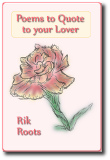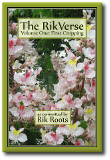Now some people counter this argument with an argument along the lines of "more poetry books and magazines are being sold today than have ever been sold before" - which is an interesting argument. Except that more of everything is being sold today than has ever been sold before. So if this argument is to be valid someone has to sit down and work out what percentage of (let's make this easier) the total written commodity market did poetry garner in 1800, 1850, 1900, 1950 and 2000. Then if the percentage of poetry has remained stable or has been rising then there is indeed no death of poetry, everything's hunky dory, etc, etc and so forth.
I haven't done the calculations, but my gut feeling is that poetry has a declining share of both the written commodities market and the wider entertainment market. Indeed, I'd be surprised if poetry managed to break 1% total share. Please, feel free to call me a cynic, but I think poetry got sick when newspapers arrived. Modern novels put poetry in the mortuary; movies buried it and TV wrote the epitaph. Only the ghost of poetry survives nowadays, haunting the other media formats with a strophe here and a stanza there.
Even so, this answer doesn't feel right to me. It's too, well, two-dimensional. Too simple an answer. I get the feeling that poetry does matter to an awful lot of people. In fact I'd say most people not only come into contact with poetry on a fairly regular basis, but also make use of poetry at important times in their lives. I'd say that it's not poetry that's been pushed into a corner, but rather commercial poetry, the industry of poetry.
Why say this, Rik?
Well, lets use my abysmal understanding of economics to try and dissect the problem.
Firstly, we need to work out who are the key players in the poetry market. Then we need to consider what markets are at work within the generic "poetry market".
Don't panic, dear reader. This shall be fun!
The key players question is fairly simple - on the "commercial" side at least. We have supply - poets and poems, and we have demand - audiences, readers, consumers of poetry. And then we have the people who bring the supply and demand together. To simplify things I'll call these people organisers, who use manufacturers to mass produce copies of the product.
Summarising the key players, we get:
- the supplier (poet) writes the product
- the product is the poem itself, or a collection of poems
- the manufacturer makes many copies of the product
- the organiser arranges the exchange of the product between supplier and consumer
- the consumer is the person who reads or listens to the product
But how do consumers consume poetry? And what do I mean by "commercial" poetry?
I think there are two modes of poetry, which get consumed in different ways. Commercially (C) consumed poetry is where the consumer goes out hunting for poetry, whereas socially (S) consumed poetry is where poetry happens to the consumer without them seeking, expecting or even wanting it.
I also think we need to add in some details about how the poetry is consumed. For this, we can look at the formality of the transaction and the relationship between consumer and supplier:
1. poetry as group entertainment or ritual - formal social events
2. poetry as social gifts or study - informal social events
3. poetry as personal entertainment or study
Mix these up and we get 6 basic groups - or markets - for poetry:
C1 - commercial consumption in groups, with the supplier reading aloud while others listen
C2 - commercial consumption in groups, with all reading and discussing the product as part of a group activity
C3 - the consumer reads (or listens to) the commercial product on their own
S1 - social consumption in groups as part of a formal ceremony
S2 - social consumption as part of a gift economy (eg birthday cards)
S3 - social consumption by consumers coming into casual contact with the product for a short duration, often where the product is designed to entice
Well, this is all very nice, but what does it mean? "Give examples, Rik!" I can hear you both shouting. Well, here's some example models, but only because it's a slow lunch hour and I'm a naturally kind person.
C1 - the poetry reading model: the organiser (who may be the publisher, or an event organiser) brings the supplier and the consumer together into one place where the supplier can give the product to the consumer direct. The consumer generally pays the organiser for entry, who then pays the supplier for their time.
C2 - the book club model: the organiser (which in this case is rarely the publisher, but may often be a group of consumers working as a partnership) purchases copies of the product and then perform and discuss it within their group. Generally the supplier is not present.
Variations on C2 could include:
the workshop model, where the supplier is present and in effect exchanges copies of the product with other group members for their time in critiquing it (though the social contract normally extends to reciprocal conduct so that it appears time is being exchanged betweeen group members and product is incidental to the transaction); and
the discussion down the pub model, where one of the consumers recites the product from memory for the entertainment of other consumers - here the producer, organiser (in as much as pub landlords and website owners are passive participants) and manufacturer are all knocked out of the transaction. It looks a bit like a peer-to-peer filesharing model. Posting poems by third parties to newsgroups, email groups and bulletin boards can be viewed in the same light. (This could be thought of as social activity, but in reality it's sharing commercial product in ways which may often infringe copyrights).
C3 - the book publishing model: this is the classic model, where the producer licences (ie sells a copyright to) an organiser, who in turn contracts with a manufacturer (treat printing and distribution as the same thing) to produce many copies of the product, which then get sold on to individual consumers in the form of books, chapbooks or pamphlets. Risk here lies with the organiser.
Variations on C3 include:
the magazine/anthology model, where organisers solicit material from producers and then sell the resulting compilation of products to the consumer. This is where supply massively outstrips demand, meaning it is a demand-led market with little profit to the supplier (as risk still remains with the organiser); and
the self-publishing model, where producers pay the manufacturer direct to print copies of the product which they then promote and sell themselves to the consumer. Here, the risk remains entirely with the producer, who overtly takes on the role as their own organiser.
Moving onto social consumption of poetry, I'm not sure its as easy to come up with models. Yet it is in these models that we meet the real function of poetry within society.
S1 - the social meme model: every society, every group within society, need ways to identify members within the group, and ways of identifying their group as different to other groups. While some of these methods can be thought of as trivial - clothes, jewellery, tattoos, hair fashions - others are much deeper, and work at a much more subconscious level. Language is a key identifier, in particular dialect and idiolect. Poetry and song probably fit between the two levels - more malleable than language, but less changeable than fashion. Shared poems and songs help bind the group together beyond the casual level of aquaintanceship. Examples can include christian hymns, football terrace chants (which change words, but the chants remain fairly static), playground poetry, and the poems read out at weddings, funerals, christenings and other family and peer group events. This is powerful juju, and is not to be messed with!
S2 - the gift model: somebody actively goes out seeking poetry, but rather than use the product for their own benefit, or for the benefit of the group, they instead choose to gift it to the someone else. Gift exchange is an immensely important function within human societies, and poems are often thought of as being extra special gifts - with no monetary value, but immense social capital invested in them. Hallmark poetry is the most commercial manifestation of this sort of poetry. Far more powerful is the poem written by one consumer (not poet!) for another - love poems, poems of condolence, poems of solidarity: all these manifestations of gift poetry that can rarely reach the level of greatness (or even competence), and yet become some of the most cherished works of poetry both to the giver and the receiver. This juju has the potential to be more potent than any other, and it is the confusion between this model of a poetry market and the commercial models of poetry that leads to the most grief on all sides.
S3 - the jingle model: quite simply, the use of poetry to advertise or pursuade the casual reader or listener to invest in the product, service or belief being advertised. While the intent of the suppliers and organisers may be driven by highly overt commercial considerations, the reality for the consumer is on a social level - they have not sought out this poetry, but rather it is foisted on them, furthermore the purpose of the interaction is not the poetry itself, but other products which the poetry is seeking to promote. Anyways, advertising is as old as the hills, and an intrinsic part of human society so I'm including this model here!
Well, lunch break was over 5 minutes ago. So no time for conclusions. Are conclusions even needed? I'm not sure - just thinking about these different types of model is beginning to help me see the why of poetry a little more clearly. No idea at all if it's of any help to others.
Time for you both to delurk and tell me how mad this idea really is!










Interesting things to think about, Rik.
ReplyDeleteMy guess about poetry is that the packaging ends up befuddling the consumer. I don't go to the bookstore and buy just any book; I go to buy a book in a specific genre. "Poetry" isn't a genre. There are genres within poetry. But they are rarely separated out to allow the reader to find them. So, they are forced to trudge through loads of things that don't interest them to get to the things that do. Rather like being forced to watch all TV just to get to the program you might like.